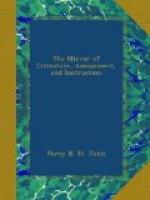In Britain, we are informed that St. Alban, the first martyr for Christianity in this country, was a great patron of the masons, and procured leave from the King or Emperor Carausius for a general meeting or assembly to be held by them, and higher wages to be given them. But we have no good reason, I think, to believe that these masons had much connexion with our fraternity, nor that freemasonry was introduced into Britain before the time of St. Austin, who, with forty more monks, among whom the sciences were preserved, was commissioned by Pope Gregory to baptize Ethelbert, King of Kent. About this time appeared those trading associations of architects who travelled over Europe, patronised by the See of Rome. The difficulty of obtaining expert workmen for the many pious works raised at that time in honour of religion, made it prudent to encourage, by peculiar privileges, those bodies of men, who had devoted themselves to the study and practice of architecture. Accordingly they were allowed to have their own government without opposition, and no others were permitted to work on any building with which they were concerned. They were under regular command, divided into lodges, with a master and wardens in each, and dwelt in an encampment near the building they were employed to erect.
It is not in my power to trace the progress of these lodges of masons in any connected history, but I will proceed with the accounts we have of the masons in England from the time of St. Austin. By them the old cathedral of Canterbury was built, in 600; St. Paul’s, London, 604; and St. Peter’s, Westminster, 605; with many others. In the year 680 some more expert brethren from France were formed into a lodge, under the direction of Bennet, Abbot of Wirral, who was appointed superintendent of the masons by Kinred, King of Mercia. From this time, however, little is known of the fraternity, until the year 856, when St. Swithin was the superintendent, appointed by Ethelwolf; from which time it gradually improved till the year 872, when King Alfred took the command of it. Upon his death, in 900, when Edward succeeded to the throne, and Ethred, Prince of Mercia, patronised the society, Edward was succeeded, in 924, by his son, Athelstan, whose brother, Edwin, procured from the king a charter for the masons, by which they were empowered to meet annually in a general assembly, and to have power to regulate their own order. And, according to this charter, the first grand lodge of England met at York, in 926. But here it is to be remarked that the grand lodge is not to be understood as the same in those times that it is now; it was not then restricted to the masters and wardens of private lodges, but was open to as many of the fraternity as could attend: for, until late years, the grand lodge as now constituted did not exist, but there was but one family of masons; and any sufficient number of masons met together, with the consent of the civil magistrate, to practise the rites of masonry, without warrant of constitution as a lodge.




